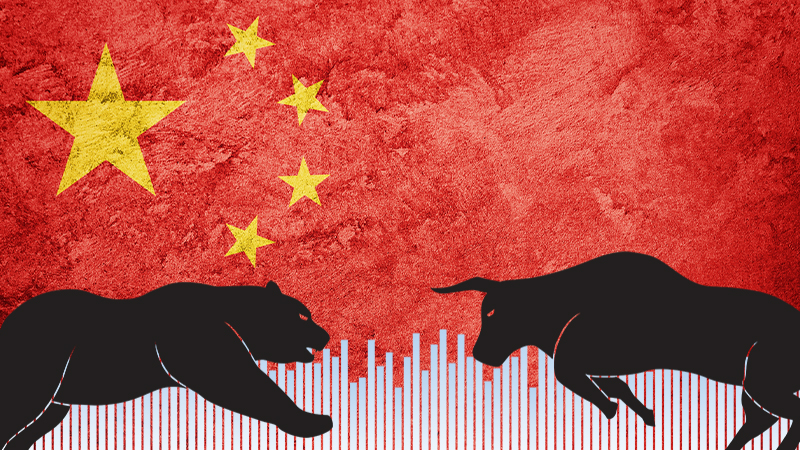The People’s Bank of China unveiled a bold stimulus package yesterday (24 September) aimed at reinvigorating the country’s flagging economy, but the move has investors divided.
Will the new measures aimed at bringing economic growth back to its 5% target mark an inflection point for China and pave the way for high returns, or will it fizzle out and disappoint as it has done so many times before?
Here, Portfolio Adviser speaks to two fund managers with very different views on the future of China.
China will do everything it takes to jumpstart the economy
While the Western world has encouraged its population to spend over the past ten years, which has powered its markets through an agitated economic landscape, the name of the game in China has been to save.
As a result, China has put its economy in a somewhat opposing position, waging a battle on deflation as the Federal Reserve and Bank of England attempt to lower to 2%. In an effort to not add onto debt, China has opted to hold strong on interest rates to prioritize currency stability.
Yet as China takes its own route through a period of economic turmoil, it also is facing the end of two long-term economic cycles. On a global scale, the country contends with a divergence from trade integration that has dominated the past 20 years. And within China, it faces the end of a 10-year economic cycle that has relied heavily on investing in the supply side of the economy to stimulate growth.
See also: Chinese markets soar following announcement of ‘aggressive’ stimulus package
Andrew Swan, head of Asia ex-Japan equities at Man Group, said: “You’ve got a combination of these things happening together, and as a result, you get a very weak economy. And the problem China has is overcapacity with weak demand, and that creates deflation, which then exacerbates the problem. So we’re kind of at that important point in time where China needs to come up with something new.”
But now, the global economy is shifting, and China has taken its queue as the value of its currency increases. Less than a week following the Federal Reserve’s pivot towards interest rate cuts, the People’s Bank of China and Chinese regulators announced a 50 basis point cut to its reserve requirement ratio and a decrease of benchmark interest rates.
“The currency has started appreciating almost to the day that it looked like the Fed was almost guaranteed to cut rates. They’re facing now a strong currency, so they can loosen as much as they want on monetary policy to stimulate the economy,” Swan said.
“The economy has been facing big, long term headwinds. But in the short term, China has been running monetary policy which is totally contrary to the way you should be doing things. But we’ve just reached an inflection point in that.”
Swan believes that the “jolt” needed for the Chinese economy has started with this week’s announcement.
“The government came out today saying ‘line in the sand here, we are going to do what it takes’. They haven’t said it explicitly, but I think effectively, that’s where we are,” Swan said.
“They understand the problems. They understand the risk of not turning this around. And what you really need now is a direction from the top to tell people now is the time to change. You need that Draghi moment. And I think they’re kind of almost there.
“If you think about what Draghi did in 2011, he saved the world by saying, ‘We will do whatever it takes’. They didn’t actually do anything, but at the end of the day, it’s that commitment that gets the private sector to do the public sector work. And that’s what China’s about to try and do. Give it the commitment to say we’ll do what it takes, but that signal line will mean the private sector does it.”
See also: Macro matters: Why managers are buying China again
While this week’s announcements could be the start of “doing what it takes”, Swan said the changes in policy on the horizon for China go much further. While these movements address some of the symptoms of the issues, Swan said China is also going after the cause. This will largely come down to incentivizing the population to spend, not save.
“Up until now, they’ve been focused on the supply in the economy, like self-sufficiency in high tech areas and new renewables. But now they have to put that focus on the demand in the economy. And if they can get more demand in the economy, you break this death spiral of prices falling,” Swan said.
“You start to get a bit of pricing power back. That means you break this deflationary cycle. It doesn’t really matter to me how significant it is, but it’s the direction of change which is most important, because if you can rebuild expectations of prices increasing into the mindset, then people will start consuming today. The biggest problem with deflation is people think prices will be cheaper in the future. So they save today, because they can get things cheaper in the future.”
But in an economy that has been conditioned to save, what causes people to start spending?
Swan believes this will begin with changes to China’s Hukou system, which currently means that social benefits are linked to one’s birthplace, not where they currently reside. Changes to this program could mean the removal of property ownership restrictions in places like Beijing and Shanghai. It could also mean placing monetary values on the plots of land given to families, which could allow for more flexibility of funds and urbanisation.
“This is not a quick fix, but it’s a change in direction from where we’ve been which I don’t think the market is fully appreciating, but I think we’re on the doorstep of this happening. It’s a really long-term, positive, incremental change,” Swan said.
“It won’t be the old China, but it certainly would be better than what we’re seeing today.”
A rally in Chinese equities never lasts
There will always been commentors singing China’s praises and proclaiming that an elusive rebound is nearing, but the truth is in the numbers. After decades of false starts and no returns to show for it, those false claims become background noise, according to Jupiter Asian Income manager Jason Pidcock.
“The pattern is that every now and then there’s a flurry of excitement around Chinese equities which is followed by a sharp move up, but then fairly quickly they go back again. And that has happened more times than I can remember over the last 30 years.
“There’s always been people saying things like ‘it looks relatively cheap’ and ‘it’s due a period of outperformance’ but I’ve learned to ignore those kind of messages.
“And you hear messages like that all the time. Every now and then Chinese equities do have a bounce and they’ll say ‘oh look I’m right,’ but every rally over the past 30 years has petered out fairly quickly.”
This happened in most recent memory when China lifted its Zero-Covid measures in late 2022. Disillusioned investors piled into Chinese equities after being promised that it was a turning point for the long-beleaguered market, but by the end of 2023, the MSCI China index had lost them another 16.2% throughout the year.
And this has happened time and again over the past decade. An investor who bought in at the peak of the 2014/15 rally – which was fuelled by a double whammy of government reform and the launch of the Shanghai-Hong Kong Stock Connect that spurred global enthusiasm – would still be down 7.3 percentage points to this day.
Investors who are being told that a resurgence in China is forthcoming would do well to take it with a pinch of salt, according to Pidcock. Especially considering that the market’s outlook today is worse than it has been in decades.
“I began investing in this region towards the end of 1993 and in that whole time Chinese equities have been pretty much the worst performing in the world,” Pidcock said. “And that was over three decades when its growth rate was one of the highest in the world.
“They started that period with low levels of debt – now they’ve got a lot of debt. And it was a period where foreign direct investment was piling into China – now it’s coming out of China. So if China was ever going to outperform, it would have been over the last 30 years.”
Despite having all these drivers behind it – ones it has now lost – the Shanghai Composite index is up roughly 50% since the start of Pidcock’s 30-year career. “That is a truly abysmal return,” he said. “I can’t find a market that’s done worse than that.”
While decisions made by the People’s Bank of China in recent days have attempted to solve some of the nation’s economic woes, the market is still littered with “so many different challenges” beyond that, according to Pidcock.
China is tackling a rapidly aging population over the long-term, with over a quarter (28%) consisting of over 60s by 2040 according to the World Health Organization, making it the fastest growing aging population in the world.
In addition to this, China is plagued by political volatility and policy uncertainty, which has turned foreign direct investment negative for the first time in decades, according to the International Monetary Fund.
See also: Fidelity’s Dale Nicholls remains ‘cautiously optimistic’ on China
After being burnt by one too many false dawns and with little to look forward to in the region, Pidcock cut China out of his £2bn Jupiter Asian Income fund in 2022. And performance has been all the better for it.
Pidcock’s fund is up 24% over the past two years whilst the average IA Asia Pacific ex Japan fund trails far behind at 4.9%.
It was the Chinese government’s crackdown on private education and technology in late 2021 that initially made Pidcock question his holdings in the region, and the more hostile signalling that ensued was the final nail in the coffin. With the situation only having worsened since, Pidcock has not looked back.
“We felt that we had to take heed of that warning, and I don’t think anyone else had. I’m not aware of any other Asia Pacific funds that reduced their China weighting so dramatically, let alone go to zero. But it has very much helped our relative performance, and the messaging has only worsened since then,” he said.
“I still have 100% conviction that was the right thing to do. I’m highly unlikely to invest in a Chinese business for years rather than months.
“Ultimately, I try to minimize unnecessary risk in everything I do, and I see investing in China as an unnecessary risk when there are much safer markets.”











